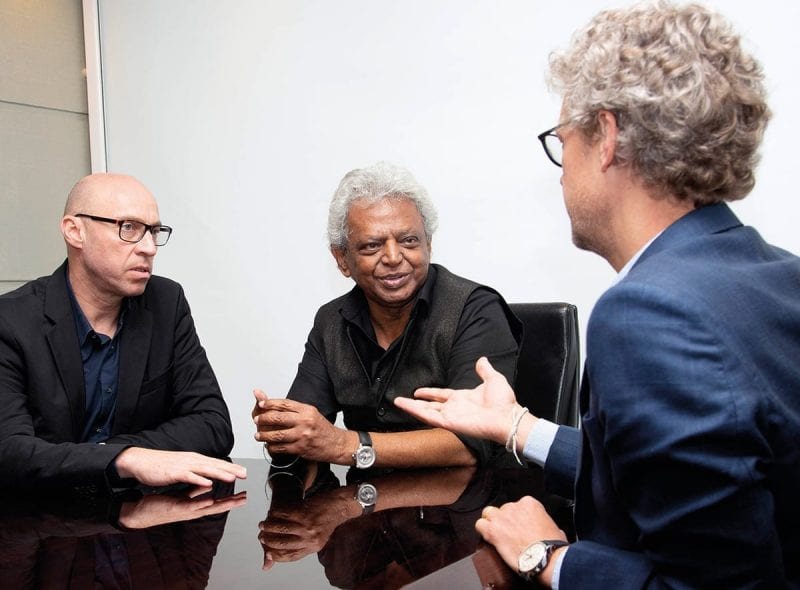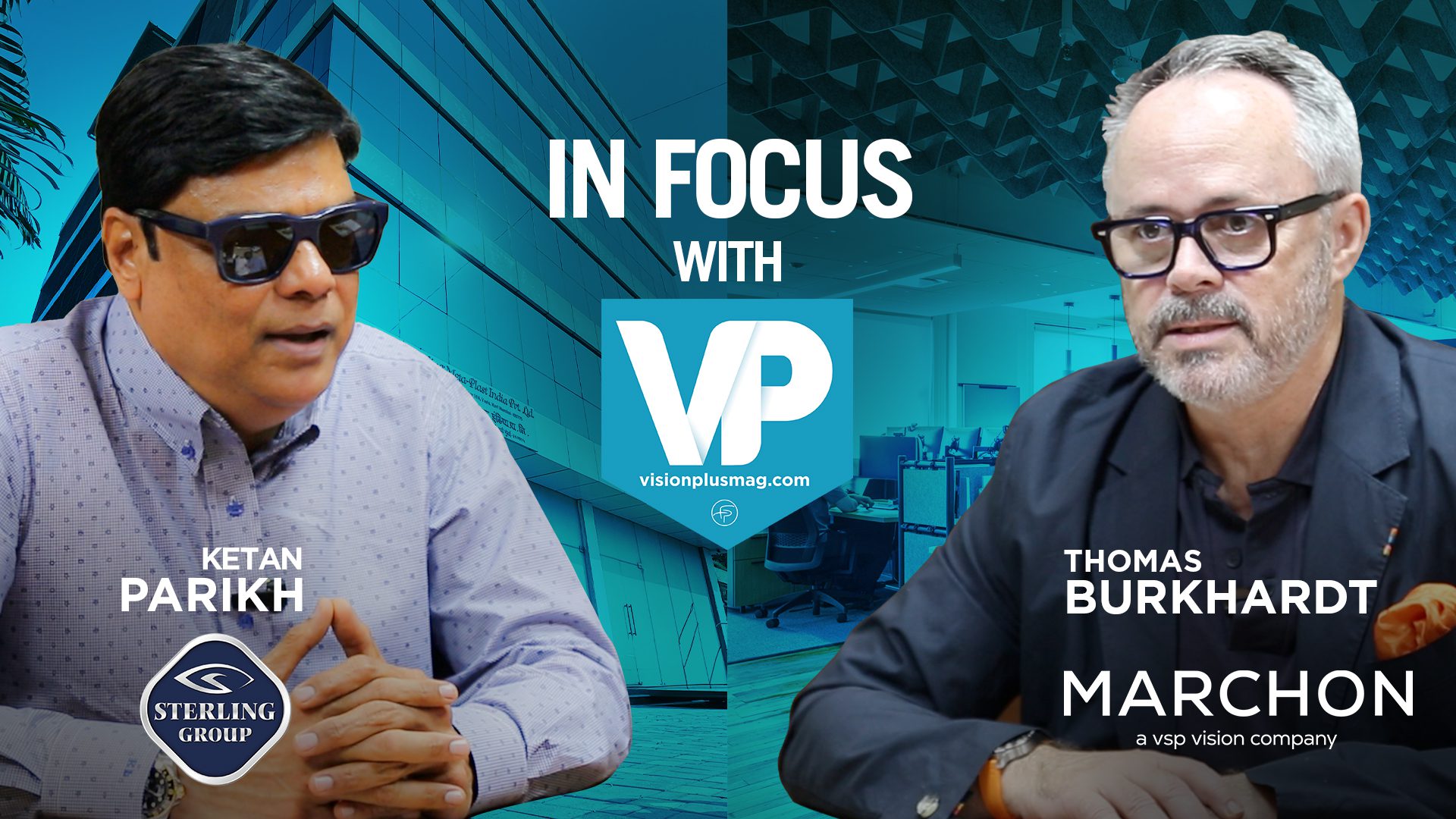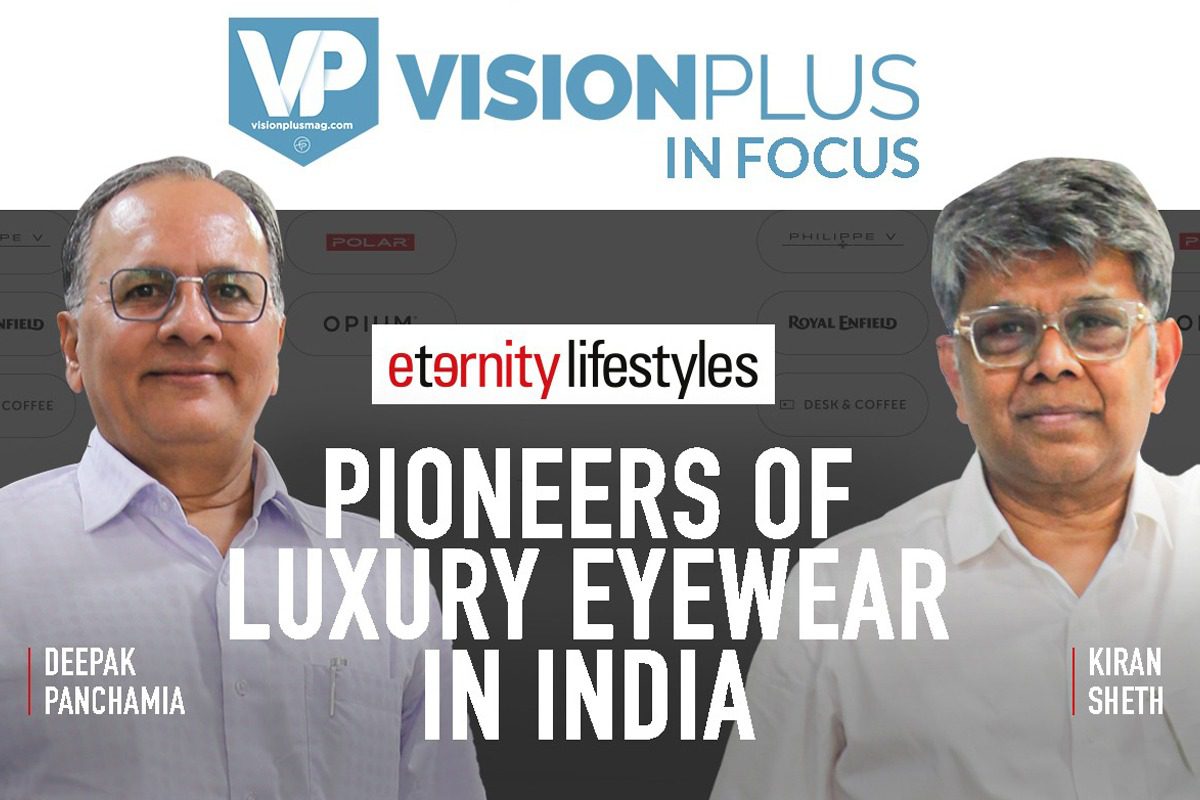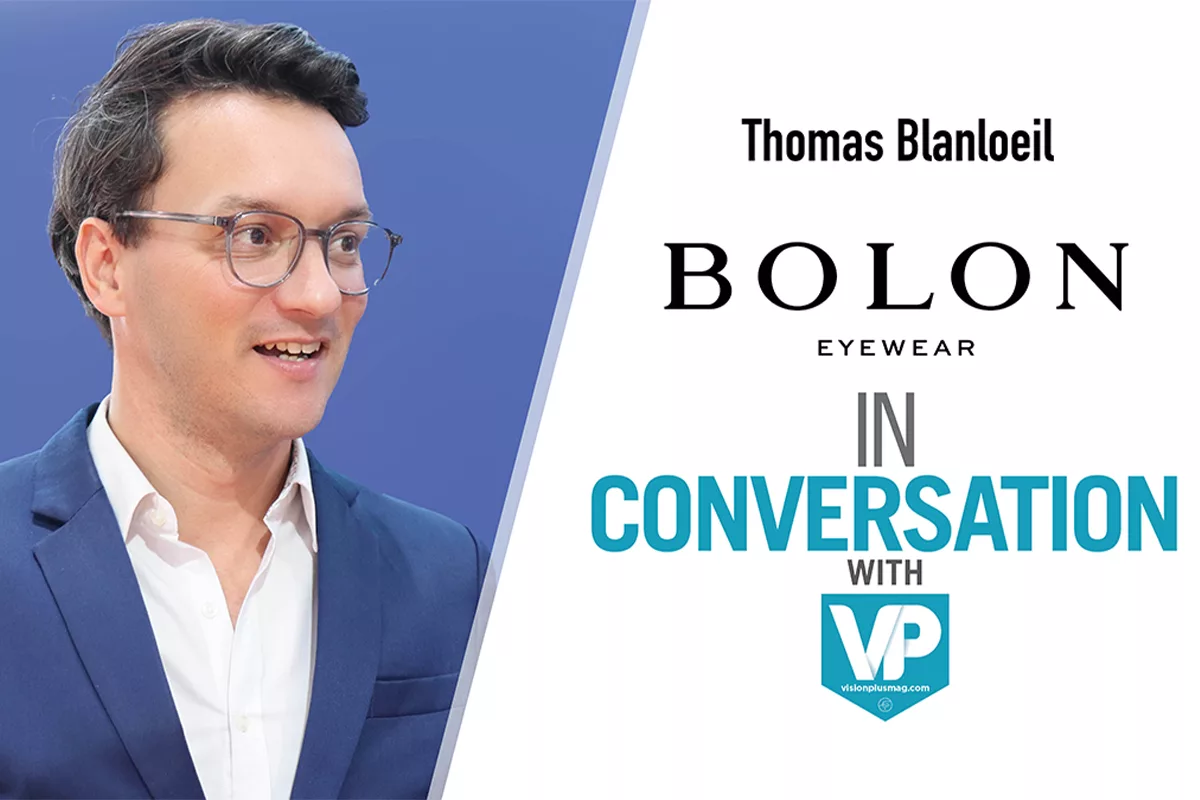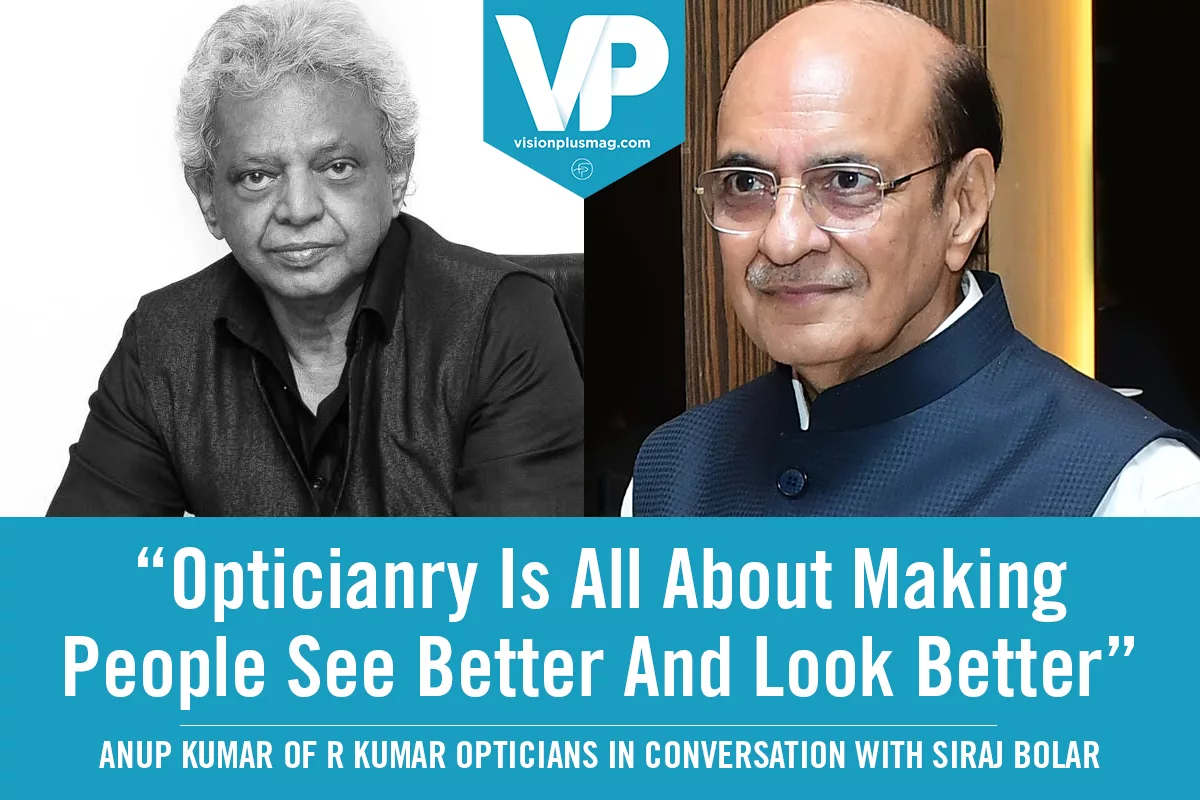Essilor responds to an outcry from opticians across India who have recently been up in arms against activities by Essilor. Bernhard Nuesser, President AMERA Region and Digital – Essilor and Maarten Geraets, CEO – Essilor, South Asia in conversation with Siraj Bolar.
Siraj Bolar : Let’s begin with a little bit about the Essilor-Luxottica merger?
Bernhard Nuesser : The worldwide industry for optics is around 100 billion Euros and if we were to compare the consumer potential to the size of this market then it’s a very small part that’s being covered. That’s the whole reason for the coming together of Essilor and Luxottica. We believe that the industry is under-represented and the market under-penetrated. As per a study conducted by an independent agency, this industry has a huge potential to grow. If the people would have access to the right product mix and the sector would reach the right markets with the 2.5 billion people who need vision correction, the industry would be probably 2 or 3 times the size of the current market. Essilor on its own cannot achieve this and hence the coming together of the two giants to help grow this market, advocate on the importance of good vision and connect people with eye care professionals to facilitate access to wide ranges of products, for the benefit of the whole optics stakeholders.

There is still much room to increase the market size. Our objective is to give a louder voice to Vision by approaching consumers, governments and NGOs to help put the case forward for Vision. And to confirm to you that this works, let me tell you that this was the first time that Vision was on the agenda for the UN when our CEO Hubert Sagnieres and Jayanth Bhuvaraghan – chief Mission Officer- represented the vision industry and presented a first of its kind Report named “Eliminating poor vision in a generation: what will it take to eliminate refractive errors by 2050?” which highlights the impact, poor vision has on economic development around the world and highlights initiatives that should be promoted to collectively solve this challenge. Thanks to the size and increased legitimacy brought by the coming together of Essilor and Luxottica, we benefit from optimized leverage and a larger footprint to bring attention to this industry. So the global ambition of EssilorLuxottica is to create a platform for the higher growth of the optical industry to benefit consumers, of course, but also all in the industry stakeholders.
Siraj Bolar : What is the vision of this merger?
Bernhard Nuesser : Essilor’s mission is about improving lives by improving sight and Luxottica’s is about aesthetic and fashion. Luxottica is positioned overall more about the premium segment while Essilor is committed to providing products and services at all price points.
The new Group’s strategy comprises the assets of both companies, translated in its mission statement: “See more, be more, and live life to its fullest” which means continuing to:
1. Help people see better (taking care of their vision needs) with advanced lens technologies
2. Help them look good and express their personality with iconic brands
3. To provide and create access everywhere in the world at all price points thanks to a unique product mix and innovative models
So EssilorLuxottica’s vision is about vision, protection and aesthetics, addressing all consumers, worldwide. So what I would like to point out is that the objective is not limited to the premium market but much wider, as we’ll continue to provide vision solutions to to every segment of the market. Consumer needs are extremely varied and evolving, so independent opticians have the opportunity to define their positioning, with a segmented based approach of the consumers they cater to. They choose the consumer segments they want to target and define the product strategy accordingly. Our objective is to ensure that each of these segments is catered to with the corresponding range of products and brands.
VisionPlus India
Click on Flipbook above to view this article on flipbook edition
Siraj Bolar : What about the acquisition by EssilorLuxottica of Grandvision, the retail giant in Europe? What has the reaction been?
Bernhard Nuesser : The reaction so far to the acquisition project has been neutral or positive. But generally people in Europe have been vocal in their support and they understand that the industry leaders can bring more value to the industry because of their superior assets in innovation and branding. Essilor has always contributed to the lens market growth by creating and developing lens categories and segmenting these categories. Luxottica has succeeded in turning eyeglasses in a beautiful and desirable fashion accessory that people want to renew as often as possible. These 2 pioneers shape the industry we know. Without their endeavor, it would probably be much smaller!
The contemplated acquisition of Grandvision is still pending regulatory approvals. In the announcement about this deal in July-2019, EssilorLuxottica said the approval process was expected to take 12-24 months to be completed. Until then the companies operate independently, including Vision Express in India.
The Grandvision acquisition aims at helping EssilorLuxottica in its efforts to increase awareness and the demand for high-quality eyewear and lenses, raise standards for service and consumer engagement across channels, and promote the importance of comprehensive eye exams. All of these factors are a catalyst for growing the entire sector, including our valued eyecare professionals.
Siraj Bolar : But how would you allay the fears of the industry that this is a process of cannibalising the market?
Bernhard Nuesser : Essilor has always been working on an open model and our innovations are available to us as well as our competitors.We deploy a a multi network approach and hence the Essilor brands are available to all our partners and sometimes even to our non-partners. This was demonstrated when we acquired Transitions : the industry thought that because we owned transitions we would exclude the rest of the market. But in fact we let Transitions be available to all players in the market and that’s the thinking we have when we say we are working in an open model in a connected world.
So going back to the original point, I reiterate that the creation of EssilorLuxottica is mainly meant to increase the size of the market, as well as push the borders of accessibility and awareness and this requires a single strong leader.
As we always did, We want to keep empowering independent opticians with products, brands and tools that help them grow on the segment they choose..
To give you an example of AMERA (our Asia, Middle East, Russia and Africa region China excepted) there are 800 million people that are probably presbyopes (+45 years old) and we sell some 20-25 million progressive lenses. This means that only 10 to 12 million consumers are benefiting from our products. So you see the potential is huge and as leaders need to help our customers the independent opticians, be able to reach out to this segment so that consumers have increaded access to the products and benefit from eyecare services,. We are more than ever committed to doing this.
Essilor has launched a program for Progressive Adaptive Lenses Acceleration in Russia and Turkey. The effect of this program is incredible:.The traditional progressive lenses market is growing 20 to 25% per year. The opticians are very satisfied with it as a major part of their income comes from progressive lenses.
And we see a lot of potential in India as well, as there’s a large segment of the population that is not very familiar with progressive lenses yet. The top opticians of our country are the kings of progressives as they are really good at this segment but a large part of independent ECPs is still struggling to understand this product and are not comfortable enough to promote it to their consumers.
Regarding sun Rx protection there is also has huge potential. Most people around the world wear glasses on one side and then when they wear plano sunglasses when it’s sunny which means that when they drive their cars they are driving with uncorrected vision. The fact is this has serious consequences as poor vision is a factor in road casualty.
And now how do we realise the potential of this segment? Do you think this or any other segment that we want to grow can be achieved by us on our own? Of course not. We need partners and our partners are independent opticians.
Siraj Bolar : The opticians in India are very upset. What do you attribute this to?
Bernhard Nuesser : India has 2 very important aspects as a market. One is the size which is huge and other is the rate of change which is very very rapid. This change includes the growth of the organised market with Lenskart and Titan and other players making inroads quite fast. The change also includes the knowledge that the consumer today has access to. They know about lenses more than they ever knew before.
So the plight of the independent optician in India has a lot to do with these 2 aspects and I can imagine and sympathize with their situation. I am sure they are wondering what’s going to happen next. And to add to this now, with Essilor and Luxottica coming together and then we have Coolwinks, which was not very well explained, and I am sure all this is making them a little upset, if that’s the right word.
Maarten Geraets : In the last 12 months a lot of new news has come from Essilor itself with the change in management and our Happiness Offers and then the Coolwinks news. This is, of course, beyond the other dynamic changes that are happening in the optical industry.
 I acknowledge that we should have communicated better with the optician community but there was a slight gap in this. We also know that communicating means repeating the message many many times. We intend to ensure that we bridge the gap between opticians and Essilor with regular communication. We need them to understand that we are their partners and we will always want to be this. We want to help the opticians win. And quite frankly the support of opticians is essential to our business and mission. We feel it’s our obligation to provide them the option to grow with the product, service and knowledge of what we have.
I acknowledge that we should have communicated better with the optician community but there was a slight gap in this. We also know that communicating means repeating the message many many times. We intend to ensure that we bridge the gap between opticians and Essilor with regular communication. We need them to understand that we are their partners and we will always want to be this. We want to help the opticians win. And quite frankly the support of opticians is essential to our business and mission. We feel it’s our obligation to provide them the option to grow with the product, service and knowledge of what we have.
We need the ECPs to win for us to win.
Siraj Bolar : Leveraging your global perspective, What are the key trends that you foresee shaping
Indian optical market in the long term?
Bernhard Nuesser : We have a market of 12000 crores in India which we believe can be much bigger. It’s growing at 10 percent per year.
And if we were to analyse where this growth is going, the trends for the last five years shows that it has gone to Lenskart, Titan and the organised chains. Also the top and well organised independent opticians have been able to garner some of this growth. But the majority of the independent opticians have not grown. So what is happening is that the industry has grown more than 5000 crores in the last few years but it’s all gone to Lenskart and some others.
We think there has to be some foothold into digital and to understand how this works and together with opticians explore this channel of growth.
Siraj Bolar : What is Essilor’s strategy and strength to win in the changing landscape? Are you moving away from the core strength of ‘Innovative Products & Brands’ and relying on ECP support in promoting your products to customers?
Bernhard Nuesser : How we continue to strengthen the brands and categories is very important. Our core strategy is to help the independent optician segment. What we have noticed is that when the market grows and the sophistication of the consumer grows, the market tends to segment. The young people go to Lenskart as they are being captured online. Lenskart is a simpler solution and its fun for the younger generation and its working.
So we are trying to put programs together for opticians that suit their segments. When we talk about Varilux or Crizal as brands etc we need to make sure that we have committed distribution and for committed distribution we have to give more than just lenses but in fact a complete marketing package as a business support package which might include eye examination or eye refraction protocol and instruments. That’s what we call as Partner Programs.
Our partner programs will be the key pillar of Essilor Brand Value Proposition. In business schools we learn that a company builds brands and has committed distribution. In India we did build the brand and now we aim to have more committed distribution. So that we are able to ensure that the segments really benefit
Regarding digital we were into it in 2010-12 when we bought framesdirect.com in the US because we knew online shopping would be a phenomenon. And then we were into it, in earnest, since 2014. But more than the ecommerce aspect we have gathered the learning from a lead generation perspective and we want to help share this with the optician community.
So we have a lead generation system where we are connecting all our websites. And we have a lot of websites like Essilor websites, e-commerce websites, we have brand websites like rayban.com etc and we are connecting all of these websites to benefit our partner ECPs.
So in the US, how this works is that we can track any consumer looking for eyewear and basically whatever the consumer searches for he is finally looking for some eye refraction test and we direct this consumer to the nearest optician. For example if you go to AllAboutVision.com we encourage consumers to search and find an optician and redirect this consumer to our ECP partners. We spent 50 million in building that system so that’s a huge commitment.
Siraj Bolar : Recent initiatives around Coolwinks have not been received well by the ECP community, who have been your supporters in the past – How will you justify this to the opticians?
Bernhard Nuesser : When we set up Coolwinks it was to learn about digital/online, learn about the changing consumer behavior, and not to let Lenskart have this opportunity for its own. We introduced Coolwinks years ago, with very few opticians and the concept was primarily a shop-in-shop one with the online option and it didn’t really work.
But we knew that there was a need for the young customer to experience something like Lenskart and we had to give them that option. So we decided recently to have the franchisee model. So we built a model store as we needed to show the ECPs what our plan was. This model store in Gurgaon is something of a template that we want to show our consumers and ECPs that this is the possibility and we want, let’s say 500 ECPs, to experience this and partner with us to share this experience with their consumers.
Now I can give an example of how European opticians took this up, I would like Indian opticians to copy this model. If you have a store that’s doing well but it’s targeted at a particular segment and you are losing the younger customers to Lenskart then add a Coolwinks franchisee close to your store and you have now opened yourself up to the younger segment. So as a smart ECP you have retained your store and its clientele and also captured the other customer who you were losing to Lenskart.
I feel this is a win win option. It’s how opticians in France and other countries have grown. And I would want the Indian ECPs to grab this opportunity too. Let’s say an optician is growing 5 to 6 percent per year but wants a faster rate of growth, this would help him achieve that. All he has to do is open a young and cheerful coolwinks store close to his traditional shop and this way retain his traditional customers and also win new customers.
There is currently no intention by Essilor to have their own stores for Coolwinks. Coolwinks exists to support independent ECPs grow their market and grab the share that they are losing to Lenskart.
And we hope that we find 200 to 400 opticians who feel that yes, that’s a good idea and it’s a good opportunity and we’d like to have it. We could even try some options where the opticians chooses to have a small section in his own shop as a coolwinks section but the better option would be to have an independent store and use it as a separate segment of his business.
Maarten Geraets : Today the consumer is looking for an alternate solution both in terms of branding and experience. And we have this proposition in Coolwinks that is satisfying that sort of consumer primarily online. And we are saying that these consumers would also like an omni channel experience. Now today Coolwinks is restricted only to online and we believe that these consumers are also looking for an experience that’s beyond just online. Now we could easily open up 500 stores for these consumers to experience these stores like Lenskart but we don’t think that’s the right approach. We believe that we should partner with ECPs and provide this opportunity to them.
Basically we are offering this platform to ECPs who have been complaining about losing their customers to Lenskart and others. On their own it would be difficult for them to combat this and so we are offering them this option to use our brand that we have created to their benefit.
Siraj Bolar : For the first time ever, Essilor came up with big consumer promotions in 2019 – what was the intent behind it? They had mixed feedback from ECP – How will you convince all that it helps the business?
Maarten Geraets : Our independent opticians do not have an offering to compete with what Lenskart is offering to the market. At the same time we know that we have an offering in terms of product with quality and branding that Lenskart cannot really match. So we decided that we should ‘excite’ the market by providing a quality proposition on Crizal to ECPs to offer to their customers. And this was based on exercises that we’ve already tried in other markets like the US, France, Brazil etc.
So these activities were not a new innovation but rather a tried and tested formula that we decided to run in India. Globally these activities have been successful for us, for the ECPs and the trade at large.
So we did the first activity of ‘Buy One Get One Free’ and we stopped it before Diwali as we thought it was not something we should be running for Diwali season. And I remember that before we launched this in India there were a lot of internal debates if this was the right thing to do and how would the opticians react etc.
And the problem was that within days the competition followed our steps and there were similar offers from all other brands as well. And we took those learnings from the first activity and tried to fix them in the next one. The idea was to provide a value proposition to help sales and to provide the customer an option to own a second pair.
And then we had a lot of feedback about the activities like maybe it was too close together and it was in the wrong season etc. And interestingly majority of the opticians we were in touch with preferred the first activity to the second one. So the first activity was better for these opticians as they did see a lot more traffic to their stores because of the publicity surrounding the activity.
The first one was the ‘Crizal Happiness Promotions’ where you buy one and get the other one free. And in this there was a 25% charge that the optician was bearing. The second one called ‘Crizal Bundle Of Happiness’ was a bundle offer where at a fixed price the consumer would get 2 pairs but there was no charge to the optician. So we had different propositions to accommodate different needs and different segments.
Also we were unable to communicate how this was a happiness offer and I’d like to convey this to the opticians more clearly. The idea is that there is a fixed cost the optician bears while selling a pair. These costs are the standard expenses that are incurred like office rent, equipment investment, salaries etc. Now when the first pair of eyewear is sold all these costs are already incurred and for the second pair this cost is almost non-existent. So the benefit of providing the second lens should be seen from this perspective. And consumers I think understand this benefit but opticians are a bit sceptical and we need to be able to convey the benefits in a more clearer manner.
Siraj Bolar : Essilor is facing ECP protest in many pockets? What’s your reaction to that?
Bernhard Nuesser : For this it’s important for me to first explain the investment in Crizal over the years in terms of media spending. Essilor was the only company a few years ago to invest so heavily into Crizal. And today you have other brands like Lenskart leveraging this benefit. So we are concerned about how to leverage our own investment and help benefit the brand Crizal. And the old method where we just talk about the benefits of Crizal will not work anymore. Today if I were to tell the consumer that Crizal is a great lens, so please buy it, it will not work. We have to excite the customer who already knows Crizal that now if you go to the optician for Crizal you will get more. This is the whole idea and point behind the campaign.
So yes, it was my idea and I forced it on the team. I would not approve any media spend just to help grow the brand more because in today’s scenario it just doesn’t work. We need to have some sort of sales enforced because of the media spend and hence the happiness offer came into place. Some of the opticians liked it, some didn’t and we learnt a few things along the way.
But the main lesson learnt is that the growth for the industry lies in ‘multiple pairs’. We have to let the end consumers know the benefits of owning multiple pairs and not just one pair forever. They need to have one for work, one for leisure and maybe one for driving and one for socialising and so on. This concept has to be driven hard into the minds of the consumer. And the happiness offer of having multiple lenses is to encourage this process.
This concept is from Coca Cola’s concept of abundance. The more coke you drink the more you want.. The more glasses of coke you have the more you want. So my request to opticians would be that we all learn by doing and let’s use these lessons to look ahead and grow together.
Siraj Bolar : Given the landscape changes, opticians are the most impacted – How will Essilor support them in these testing times
Maarten Geraets : Essilor is hugely committed to the ECP, who are at the core of our business, and ESSILOR will continue to focus on growing and developing the ECPs through strategic initiatives along with supporting them on a day to day basis similar to our efforts in the last 21 years. Our newly launched Partner Program “Essilor Expert” is one such initiative where we want to help vision oriented iECP differentiate themselves with the help of Essilor’s brand credibility. With this program we aim to support our ECPs on footfalls, upgrades, conversion and customized special offers. We plan to continue to enhance the offerings in this program to raise the standard for service & consumer engagement. We aim to have around 500 Essilor Expert stores by the end of 2020 enrolled and supported based on a fair and factual process.
Not only does Essilor bring innovative products and services, but we are also committed to continuously raise consumer’s awareness on the existing solutions, on the importance of having their vision checked and see an eye care professional. As an example, the recent renewal of the SeeNow campaign with Amitabh Bachchan and Fred Hollows Foundation. We like to explore, with our key stake-holders, is how we can drive awareness of the category even stronger. I’d like to repeat what I said in my last interview that Essilor wins when opticians win.

